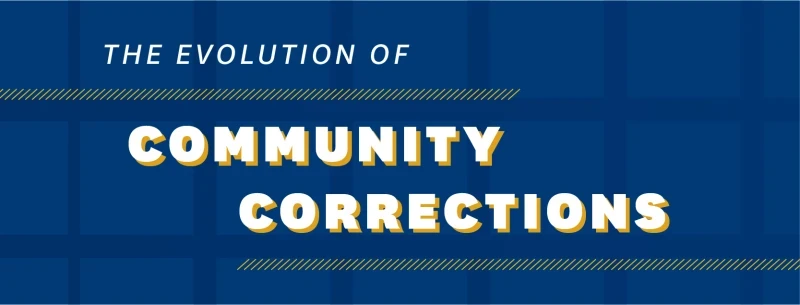“Community corrections” refers to any program that supervises offenders outside of the prison system, including probation, parole, work release, day reporting centers or residential “halfway house” programs. Community corrections has a long history in the United States, where there are presently two offenders on parole or probation for every individual currently serving time in prison.1 This long history has yielded many evidence-based practices in community corrections that are proven to decrease recidivism and are less costly than incarceration.2
The Early History of Community Corrections
Examples of community corrections can be found as early as the 1700s in England, when judges were afforded the discretion to offer “judicial reprieve,” essentially a way to convict an offender of a crime (usually a minor infraction), while still allowing them to enjoy the full freedoms of citizenship.
In the United States, the concept of “recognizance,” releasing a guilty offender because of their own regret, came into popular usage in the 19th century. Recognizance offered the opportunity for an offender (often a juvenile) to escape the full judgment of the law, while reserving the right of the court to issue punishment for the original crime if further infractions occurred.3
The Birth of Probation in the U.S.
The practice of probation in the United States is usually traced to John Augustus, a cobbler and philanthropist from Boston. In 1841, the temperance movement was in full effect, criminalizing intoxication and alcoholism. As a volunteer of the court, Augustus worked hard to rehabilitate alcoholics he saw processed through the legal system.
One day, Augustus witnessed a man who was likely going to be sentenced to prison time. He paid the man’s bail, and personally promised the court that the man would return at a designated time for further evaluation. Augustus offered support and safety to his charge, helped him find a job, and worked to help him become a productive member of society once again. When the man returned to the court, the judge was so impressed with the turnaround that he was only charged court fees and a one-cent fine.2
Contemporary Community Corrections
Obviously, a lot has changed since the end of the 19th century. What hasn’t changed is that as much as the justice system seeks retribution for the wronged, it also seeks rehabilitation for wrongdoers. Now, the United States has the largest incarcerated population in the world, though 95 percent of offenders can expect to be released from prison and reintegrated into society through some form of community corrections.4
Until very recently, little money and energy was put into understanding the efficacy of various community corrections methods, but as the incarcerated population grows in size and cost, governments and research institutions are seeking new ways to reintegrate offenders into society. Thanks to a growing body of research, we now have some idea of the most effective ways to pursue community corrections.
- Assess risks and needs. Risk/needs assessment is the most critical component of a successful community corrections program. Behavioral data can be collected, maintained and used to assess the future risk of reoffending, which in turn suggests to supervisors the program that will be of most benefit to each offender on an individual basis.2
- Enhance intrinsic motivation. Rehabilitation is more often than not about an offender reckoning with the issues and behaviors that lead to criminality. Even though extrinsic motivation may serve in the short turn, working motivationally with offenders to develop their own intrinsic sense of motivation is proven to be a more effective strategy for reducing recidivism.5
- Target interventions. Every person is different. They respond differently to authority, motivation and goals. For this reason, it’s important that community corrections be targeted and specific. High-risk offenders should be prioritized, and intervention must be calibrated to the temperamental and cultural needs of each offender.
- Practice makes perfect. Evidence indicates that cognitive-behavioral therapy is generally effective. This involves not only discussing strategies to cope with reintegration to society, but also practicing and role-playing those strategies. Pro-social attitudes and behaviors can also be positively reinforced by supervision.
- Increase positive reinforcement. As discussed above, rehabilitation requires positive reinforcement. As the saying goes, the most successful community corrections measures approach offenders with the carrot, not the stick.
- Measure and report outcomes. All community corrections efforts and their effectiveness should be documented and measured. Each case presents the opportunity to refine and update methods to increase efficacy moving into the future.
The Future of Community Corrections
Two major movements in community corrections are gaining steam: the integration of technology and the recognition that “wraparound services” can be effective.6 Monitoring technology, drug tests, alcohol breathalyzers and other devices are enabling remote monitoring which will cut down on overhead costs for supervising agencies, and can enable a greater degree of understanding of what happens when offenders aren’t being directly observed.
Meanwhile, many agencies are recognizing the importance of offering a full suite of services, including residential, mental health, alcohol and drug rehabilitation, and more to offenders. By coordinating several agencies, workloads can be decreased since an entire team is working together on a treatment and reintegration plan.
Make your mark on the future of community corrections and criminal justice. Explore the online Master of Arts in Criminology and Criminal Justice from Kent State University, and prepare yourself to serve as a next-generation leader in this multidimensional field.
Sources:
- Retrieved on May 2, 2018, from bjs.gov/content/pub/pdf/cpus15.pdf and bjs.gov/content/pub/pdf/ppus15.pdf
- Retrieved on May 2, 2018, from pewtrusts.org/~/media/legacy/uploadedfiles/wwwpewtrustsorg/reports/sentencing_and_corrections/qacommunitycorrectionspdf.pdf
- Retrieved on May 2, 2018, from us.sagepub.com/sites/default/files/upm-binaries/86776_Chapter_1_Definitions%2C_History%2C_and_Development_of_Community_Corrections.pdf
- Retrieved on May 2, 2018, from pewtrusts.org/~/media/legacy/uploadedfiles/pcs_assets/2008/policy20frameworkpdf.pdf
- Retrieved on May 2, 2018, from s3.amazonaws.com/static.nicic.gov/Library/019342.pdf
- Retrieved on May 2, 2018, from pbis.org/school/tertiary-level/wraparound





